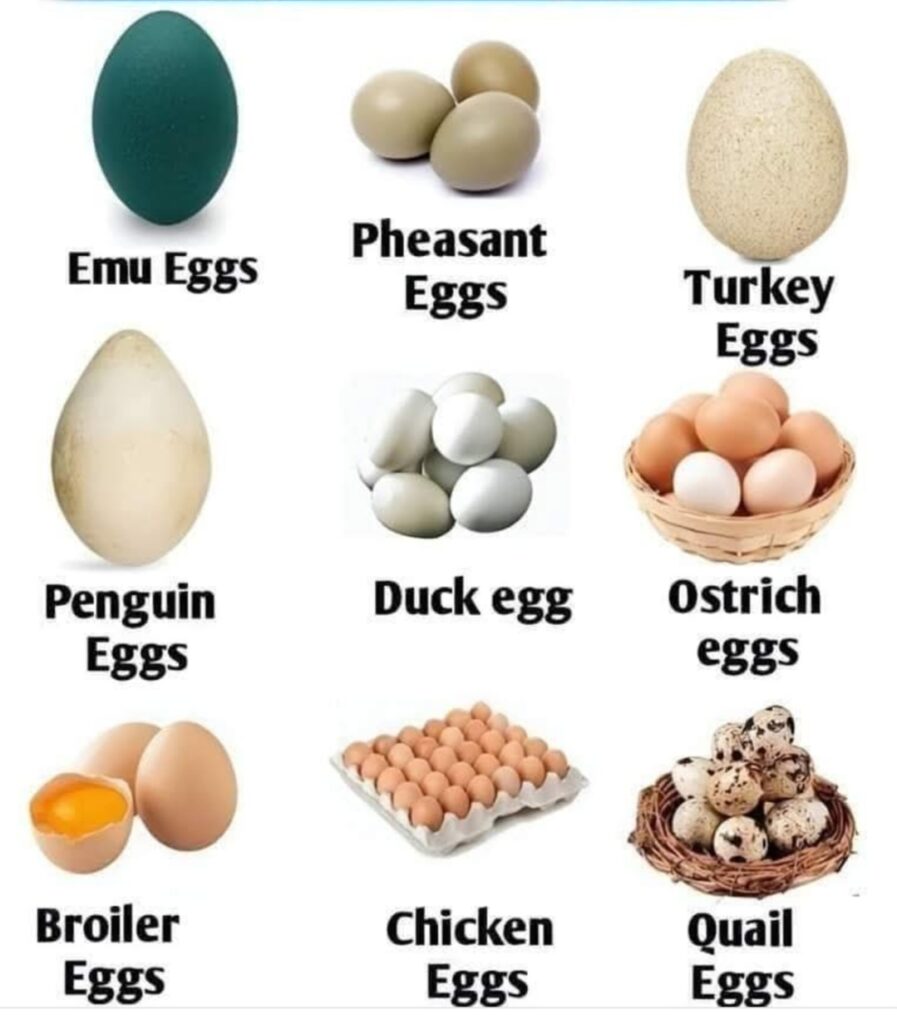
Eggs are among the most nutritious foods on the planet. Everyone one earth only know egg as a good source of protein. But it also contain other nutrients. A whole egg for example, fowl egg contains all the nutrients required to turn a single cell into a baby chick.
The primary role of egg production is to reproduce the species of the parent. All female animals produce eggs which are fertilized to produce a new offspring of their kind. But not all eggs produced by animals are consumable. The most widely consumed eggs are those from poultry, especially fowl. Other birds that produce eggs for consumption include; duck, turkey, geese, Ostrich, quil, Emu, turkey ,guinea fowl, pigeons, pheasants,and some other wild birds.

Their eggs especially ducks and ostriches, are eaten regularly but much less commonly than those of fowl. Duck eggs are consumed as food in parts of Europe, Africa and Asia. Goose eggs are also a food in many European countries. Commercial production of turkey and pigeon eggs is almost entirely confined to those used for producing turkey poults and young pigeons (squabs). Pheasant and quail eggs provide birds for hobby or sport use. People may also eat the eggs of reptiles, amphibians, and fish. Fish eggs consumed as food are known as roe or caviar.

Eggs are produced in various sizes. Fish eggs are very small in size, Quil eggs are a bit bigger in size, while ostrich egg is the largest egg from Aves.
All creatures that lay eggs especially hens are raised throughout the world, and mass production of fowl/chicken eggs is a global industry. In 2009, an estimated 62.1 million metric tons of eggs were produced worldwide from a total laying flock of approximately 6.4 billion hens.

Smaller eggs, such as quail eggs, are used occasionally as a gourmet ingredient in Western countries. Eggs are a common everyday food in many parts of Asia, such as China and Thailand, with Asian production providing 59 percent of the world total in 2013.
The largest bird eggs, from ostriches, tend to be used only as special luxury food. Gull eggs are considered a delicacy in England, as well as in some Scandinavian countries, particularly in Norway. In some African countries, guineafowl eggs often are seen in marketplaces, especially in the spring of each year. Pheasant eggs and emu eggs are edible, but less widely available, sometimes they are obtainable from farmers, poulterers, or luxury grocery stores.
In many countries, wild bird eggs are protected by laws which prohibit the collecting or selling of them, or permit collection only during specific periods of the year.
In 2017, world production of chicken eggs was 80.1 million tonnes. The largest producers were China with 31.3 million of this total, the United States with 6.3 million, India at 4.8 million, Mexico at 2.8 million, Japan at 2.6 million, and Brazil and Russia with 2.5 million each. The largest egg factory in British Columbia, for example, ships 12 million eggs per week.
In year 2019, the United States produced 9.41 billion eggs, with 8.2 billion for table consumption and 1.2 billion for raising chicks. Americans are projected to each consume 279 eggs in 2019, the highest since 1973, but less than the 405 eggs eaten per person in 1945
The World Health Organization (WHO) specified a daily egg limit for healthy adults, but research suggests that moderate egg consumption, including up to one egg per day, is generally safe and not associated with increased cardiovascular disease risk.
This can be broken down in more detail. For healthy adults, one egg per day, is recommended as part of a balanced diet, is generally considered safe. While
WHO guiding principles for feeding breastfed and non-breastfed children state that “meat, poultry, fish or eggs should be eaten daily, or as often as possible”. WHO also states that children who consume eggs and flesh foods have higher intakes of various nutrients important for optimal linear growth. Many people can eat a couple of eggs per day. But the amount may vary for certain groups. In parts of the world where eggs are affordable and easily accessible, many people eat them regularly or even daily.
For a healthy adult with normal cholesterol levels and no significant underlying heart disease risk factors, some research suggests that 1–2 eggs per day can be safe. It may even be healthy and benefit human heart health.
NUTRIENT COMPOSITION OF EGG
A single large boiled egg contains:
Vitamin A: 8% of the DV (daily value)
Folate: 6% of the DV
Pantothenic acid (vitamin B5): 14% of the DV
Vitamin B12: 23% of the DV
Riboflavin (vitamin B2): 20% of the DV
Phosphorus: 7% of the DV
Selenium: 28% of the DV
Eggs also contain decent amounts of vitamin D, vitamin E, vitamin B6, calcium and zinc
This comes with 78 calories, 6 grams of protein, and 5 grams of fat.
Eggs also contain various trace nutrients that are important for health.
They also contain omega-3-enriched compunds, making it a more nutrient-dense food source. They contain higher amounts of omega-3 fat and are much higher in vitamins A and E.
STRUCTURAL COMPONENTS OF EGG
The structural components of the egg include the shell and shell membranes (10 percent); the albumen or white (60 percent), including the thick albumen, the outer thin albumen, the inner thin albumen, and the chalazae; and the yolk (30 percent).
In a fertilized egg, the yolk supplies the nutrients and the albumen supplies the water necessary for the development of the embryo. In addition, the layers of albumen act as a cushion to protect the embryo from jarring movements, while the chalazae help to maintain the orientation of the embryo within the egg.
Schematic of a chicken egg:

Eggshell
Outer membrane
Inner membrane
Chalaza
Exterior albumen
Middle albumen
Vitelline membrane
Nucleus of Pander
Germinal disc (nucleus)
Yellow yolk
White yolk
Internal albumen
Chalaza
Air cell
Cuticula
Bird and reptile eggs consist of a protective eggshell, albumen (egg white), and vitellus (egg yolk), contained within various thin membranes. The egg yolk is suspended in the egg white by one or two spiral bands of tissue called the chalazae (from the Greek word χάλαζα, meaning ‘hailstone’ or ‘hard lump’). The shape of a chicken egg resembles a prolate spheroid with one end larger than the other and has cylindrical symmetry along the long axis.
AIR CELL:
The larger end of the egg contains an air cell that forms when the contents of the egg cool down and contract after it is laid. Chicken eggs are graded according to the size of this air cell, measured during candling. A very fresh egg has a small air cell and receives a grade of AA. As the size of the air cell increases and the quality of the egg decreases, the grade moves from AA to A to B. This provides a way of testing the age of an egg: as the air cell increases in size due to air being drawn through pores in the shell as water is lost, the egg becomes less dense and the larger end of the egg will rise to increasingly shallower depths when the egg is placed in a bowl of water. A very old egg will float in the water and should not be eaten, especially when foul odour is detected when the egg is cracked open.
SHELL
(EGGSHELL COLOUR)
Eggshell colour is caused by pigment deposition during egg formation in the oviduct and may vary according to species and breed. It ranges from white to brown to pink or speckled blue-green colour. The brown pigment is protoporphyrin IX, a precursor of heme, and the blue pigment is biliverdin, a product of the breakdown of heme.
BREEDS THAT LAY COLOURED EGGS
Fowl breeds with white ear lobes lay white eggs, whereas those with red ear lobes lay brown eggs. Although there is no significant link between shell colour and nutritional value. But there is a cultural preference for one colour over another. As candling is less effective with brown eggs, they have a significantly higher incidence of blood spots.
MEMBRANE
(EGGSHELL MEMBRANE )
The eggshell membrane is a clear film lining the eggshell. It becomes visible when an egg is peeled after boiling. Primarily, it is composed of fibrous proteins such as collagen type I. These membranes may be used commercially as a dietary supplement.
WHITE
(EGG WHITE )
“White” is the common name for the clear liquid (also called the albumen or the glair/glaire) contained within an egg. It is colourless and transparent initially, but upon cooking it turns white and opaque. In fowl, it is formed from the layers of secretions of the anterior section of the hen oviduct during the passage of the egg. It forms around both fertilized and unfertilized yolks. The primary natural purpose of egg white is to protect the yolk and provide additional nutrition during the growth of the embryo.
Egg white consists primarily of approximately 90 percent water into which is dissolved, 10 percent proteins (including albumins, mucoproteins, and globulins). Unlike the yolk, which is high in lipids (fats), egg white contains almost no fat and the carbohydrate content is less than one percent. Egg white has many uses in food and many other applications, including the preparation of vaccines, such as those for influenza.
YOLK
(EGG YOLK )
The yolk in a newly laid egg is round and firm. As the yolk ages, it absorbs water from the albumen, which increases its size and causes it to stretch and weaken the vitelline membrane (the clear casing enclosing the yolk). The resulting effect is a flattened and enlarged yolk shape.
Yolk colour is dependent on the diet of the hen. If the diet contains yellow or orange plant pigments known as xanthophylls, then they are deposited in the yolk and colour it. Lutein is the most abundant pigment in egg yolk. A diet without such colourful foods may result in an almost colourless yolk. Yolk colour is, for example, enhanced if the diet includes foods such as yellow corn and marigold petals. In places like the US, the use of artificial colour additives is prohibited.
All the fats, or lipids, as well as the cholesterol are found in the yolk. Yolk lipids are high in unsaturated fatty acids, with the ratio of unsaturated to saturated fatty acids commonly being 2 to 1. By influencing the diet of the hen, some processors are able to market shell eggs with a higher ratio of unsaturated to saturated fatty acids. Particular emphasis is being given to increasing the highly unsaturated long-chain omega-3 fatty acids by adding fish oil to the hen feed. Omega-3 fatty acids have been shown to play a role both in normal growth and development and in the prevention of many diseases.
ABNORMALITIES
Abnormalities that have been found in eggs purchased for human consumption include:
1. DOUBLE-YOLK EGGS: Atimes, an egg may contain two or more yolks. Most people believe that only big in size eggs possess two yolks. Two yolk in eggs only occur when ovulation takes place too rapidly, or when one yolk becomes joined with another yolk.
2. YOLKLESS EGGS: This egg contains only the white but no yolk. This usually occur during a pullet’s first effort to lay. It is produced before the hen’s laying mechanism is fully ready.
3. DOUBLE-SHELLED EGGS: An egg may have two or more outer shells due to a counter-peristalsis contraction. It usually occur when a second oocyte is released by the ovary before the first egg has completely traveled through the oviduct and been laid.
4. SHELL-LESS OR THIN-SHELLED EGGS: This may be caused by egg drop syndrome.
POULTRY EGGS ON FARM
Most commercially farmed chicken eggs intended for human consumption are unfertilized, since the laying hens are kept without roosters. Fertile eggs may be eaten, with little nutritional difference when compared to the unfertilized. Fertile eggs will not contain a developed embryo, as refrigeration temperatures inhibit cellular growth for an extended period of time. Sometimes an embryo is allowed to develop, but eaten before hatching as with balut.
EGG GRADING BY QUALITY AND SIZE (GRADING CHICKEN EGG INTO SIZES)

a. SORTING
Eggs can be sorted by size and quality. In the United States eggs are sized on the basis of a minimum weight per dozen in ounces. One dozen extra large eggs weigh 27 ounces (765 grams); large eggs, 24 ounces; medium eggs, 21 ounces. Weight standards in other countries vary, but most are measured in metric units. For example, eggs might be sold in cartons of 10 eggs each. While in African countries like Nigeria, eggs are sold in crates of 30 pieces.
b. SIZING
In the US, eggs classified as “large” are those eggs that yields 50 grams by weight without shell. This same size of egg is classified as “medium” in Europe and “standard” in New Zealand. Such eggs that weigh 50-gram (1.8 oz) provides approximately 70 kilocalories (290 kJ) of food energy and 6 grams of protein.
c. FACTORS THAT AFFECT EGG QUALITY
1. For boiled Eggs : Such eggs supply several nutrients, vitamins and minerals with Daily Value (DV per 100g) including:
vitamin A (19% DV),
riboflavin (42% DV),
pantothenic acid (28% DV),
vitamin B12 (46% DV),
choline (60% DV),
phosphorus (25% DV),
zinc (11% DV)
and vitamin D (15% DV).
2. Cooking methods also affect the nutritional values of eggs.
3. The diet of laying hens also may affect the nutritional quality of eggs. For instance, chicken eggs that are especially high in omega-3 fatty acids are produced by feeding hens a diet containing polyunsaturated fats from sources such as fish oil, chia seeds, or flaxseeds.
4. Pasture-raised free-range hens, which forage for their own food, also produce eggs that are relatively enriched in omega-3 fatty acids when compared to those of cage-raised chickens.
5. Egg contamination by pathogenic bacteria
Most eggs sold in modern supermarkets are approximately four to five days old. If kept refrigerated by the consumer, they will maintain good quality and flavour for about four weeks.
d. SCALE FOR GRADING EGGS
A SCALE
The U.S. Department of Agriculture grades eggs by the interior quality of the eggs and the appearance and condition of the egg shell. Eggs of any quality grade may differ in weight (size).
1. Grade AA and Grade A eggs: These are best eggs for frying and poaching, where appearance is important.
2. U.S. Grade AA
These eggs have whites that are thick and firm; have yolks that are high, round, and practically free from defects; and have clean, unbroken shells.
3. U.S. Grade A
These eggs have characteristics of Grade AA eggs except that the whites are “reasonably” firm.
This is the quality most often sold in stores.
4. U.S. Grade B
These eggs have whites that may be thinner and yolks that may be wider and flatter than eggs of higher grades. The shells must be unbroken, but may show slight stains.
This quality is seldom found in retail stores because usually they are used to make liquid, frozen, and dried egg products, as well as other egg-containing products.
In Australia and the European Union, eggs are graded by the hen raising method. That is, free range, battery caged methods, etc.
GRADING OF EGGS BASED ON BATTERY CAGE AND FREE RANGE SYSTEM
(LAYING HENS IN BATTERY CAGES )
Most Commercial poutry farm operate using the battery cage system to raise their hens. This system prevent over crowding, the hen engaging in wing-flapping, dust-bathing, scratching, pecking, perching, and nest-building. It also prevent theft to some level and predatory attack on the birds.
Hens in such confinement are easily debeaked to prevent them from harming each other and engaging in cannibalism. Eggs produced through this system are cleaner and less contaminated.
FREE RANGE SYSTEM
Free-range system is also used for laying hens as the hens are allowed to roam around in a fenced yard where they have assess to green grasses, pick on worms and insects etc during the day. Such hens are provided laying nest where they lay their eggs. Atimes, eggs are laid in hidden areas where farmers may not know. Therefore, farmers will have to move round the yard in search for eggs laid in the hidden areas. This sysem exposes the hen to many dangers ranging from weather condition to predation etc. Eggs produced through thuis system may be stained with poultry feces and other contaminants and would require extra cleaning.
Chicken eggs are also graded by size for the purpose of sales. Some maxi eggs may have double-yolks and some farms separate out double-yolk eggs for special sale.
1. Comparison of an egg and a maxi egg with a double-yolk – closed (1/2)
2. Comparison of an egg and a maxi egg with a double-yolk – opened (2/2)
3. Double-yolk egg – opened
FACTORS THAT AFFECT THE SIZE OF EGGS LAID BY HEN
1. GENETICS:
🥚 Each breed of fowl has a genetically determined egg size range. For example, Rhode Island Reds lay larger eggs than Leghorns.
2. NUTRITION:
🥚 The diet fed to hens affect their egg size. For example, hens need more methionine, cysteine, and lysine to produce larger eggs. Also, protein is needed for large egg production. Reducing the hen’s protein intake can reduce egg size.
3. ENVIRONMENT:
🥚 Lighting is an important environmental factor that can affect egg size. Light significantly impacts the size of eggs laid. It primarily influence the bird’s reproductive cycle and maturity. Longer periods of exposing hen to light, especially during the early stages of a hen’s life, can lead to larger eggs by delaying sexual maturity and allowing for increased body weight before egg laying begins.
4. BODY WEIGHT:
🥚 The hen’s body weight also affects egg size. Heavier hens tend to lay larger eggs than light weighed hens.
5. HEALTH:
🥚 The hen’s health and well-being affect egg quality. Sick or stressed hens produce lower quality eggs.
6. AGE:
🥚 The age of the hen can affect egg size. Younger hens lay eggs with stronger shells.
7. OTHER FACTORS:
🥚 Other factors like; overcrowding, noisy environments, stress factors and disturbances can stress the hen and lead to poor egg quality.
Above all, proper storage is important for maintaining egg quality. Eggs should be arranged in crates and kept in a cool, dry place.
COLOUR OF EGGSHELL
Fowl eggs can be in White, speckled (red), and brown in colour. Producers and breeders often refer to brown eggs as “tinted”, while the speckled eggs preferred by some consumers are often referred to as being “red” in colour.
Eggshell colour has being a large cosmetic issue all over the world. The colour has no effect on egg quality or taste, it is a major issue in production due to regional and national preferences for specific colours, and the results of such preferences on demand. For example, in most regions of the United States, chicken eggs generally are white. However, brown eggs are more common in some parts of the Northeastern United States, particularly New England, where a television jingle for years proclaimed “brown eggs are local eggs, and local eggs are fresh!”.

BREEDS THAT LAY COLOURED EGGS
Local fowl breeds, including the Rhode Island Red, lay brown eggs. Brown eggs are preferred in China, Costa Rica, Ireland, France, and the United Kingdom. In Brazil and Poland, white chicken eggs are generally regarded as industrial, and brown or reddish ones are preferred. Small farms and smallholdings, particularly in economically advanced nations, may sell eggs of widely varying colours and sizes, with combinations of white, brown, speckled (red), green, and blue (as laid by certain breeds, including araucanas, heritage skyline, and cream leg bar) eggs in the same box or carton, while the supermarkets at the same time sell mostly eggs from the larger producers, of the colour preferred in that nation or region.
Very dark brown eggs of Marans. This is a French breed of fowl
EFFECT OF CULTURE ON EGGSHELL COLOUR DEMAND
Cultural has being a major determinant for egg demand in many countries over years. The New York Times reported during the Second World War that housewives in Boston preferred brown eggs and those in New York preferred white eggs. Also, in the 70s, a magazine called the New Scientist magazine, reported that “Housewives are particularly fussy about the colour of their eggs, preferring even to pay more for brown eggs although white eggs are just as good”. As a result of these trends, brown eggs are usually more expensive to purchase in regions where white eggs are considered “normal”, due to lower production. In France and the United Kingdom, most supermarkets are supplied only brown eggs due to its demand over white eggs. While in Egypt, brown eggs are less demanded for, white eggs are most demand for.
In the 90s, Japanese housewives where reported to have high preference white colourd eggs. Hen egg colour was a distinct factor as at then in Japan.
Also in the 1970s, French institute reported production of blue chicken eggs from the Chilean araucana fowl. These eggs were stronger and more resilient to breakage.
With regards to culture, egg producers carefully consider cultural issues when selecting the breed or breeds of fowl used for production of eggs. as egg color varies between breeds.
BENEFITS OF EGGS
EGGS have extraordinary benefits. They are the powerhouse of nutrition due to its amazing benefits in human’s body.
1. It is rich in protein for muscle growth and repair. The protein content in egg is relatively high, with all the essential amino acids in the right ratios.
Proteins are the main building blocks of the human body.
They help develop all sorts of tissues and molecules that serve both structural and functional purposes. It is important to get enough protein in the diet, and research suggests that the currently recommended amounts may be too low.
A single large egg containing six grams of protein. It also contain all the essential amino acids in the right ratios, so the body is well-equipped to make full use of the protein in them.
2. Eggs are a good source of vitamins, and minerals, including iodine, folate, and selenium. Some of the vitamins perform the following roles;
It is an excellent source of vitamin D for bone health.
Vitamin A supports eye health, vision, metabolism and cell development.
Vitamin B12 plays a role in keeping nerve cells and blood cells healthy.
Vitamin E acts as an antioxidant to protect cells from oxidative damage.
Folate (or vitamin B9) helps the body make new red blood cells and helps with the growth and development of fetus during pregnancy.
3. Good source of collagen, which improves skin elasticity and reduces wrinkles
4. Egg contain lutein and zeaxanthin. Both are antioxidants that have major benefits for eye health.
One of the consequences of aging is that eyesight tends to get worse. Eggs is a good source of nutrients that help counteract some of the degenerative processes that can affect human eyes. Both lutein and zeaxanthin in eggs which are powerful antioxidants, accumulate in the retina of the eye. Both nutrients are majorly found in the egg yolks in large amounts.
In a 2006 study, eating 1 egg daily for 5 weeks increased blood levels of lutein by 26% and zeaxanthin by 38% in older adults.
A 2022 review of research suggests consuming adequate amounts of these nutrients can significantly reduce the risk of cataracts and macular degeneration, two very common eye disorders.
Eggs are also high in vitamin A, which deserves another mention here. Vitamin A deficiency is a common cause of blindness worldwide.
5. CONTAIN CHOLINE: Choline is an important nutrient that most people do not get enough of.
Eggs are a good dietary source of choline, an important nutrient often grouped with the B vitamins.
Choline is used to build cell membranes and has various other functions, including producing signaling molecules in the brain. Thus, boosts brain function and helps the brain becomes sharper
A deficiency in this nutrient can cause serious symptoms, but because the body makes choline, deficiency is not common. However, people who are pregnant or have certain genetic alterations may be more likely to have a choline deficiency.
Whole eggs are an excellent source of choline. A single egg contains about 147 mg of choline.
6. Eggs are a good source of collagen, which is essential for healthy skin, hair, and nails.
7. Its cholesterol level is low. Therefore, it is a good cholestral. Studies has shown that dietary cholesterol from eggs may not have the same negative impact on blood cholesterol levels.
8. A 2018 meta-analysis of randomized clinical trials found that consumption of eggs increases total cholesterol (TC), LDL-C and HDL-C compared to no egg-consumption but not to low-egg control diets.
HDL is a “good” cholesterol while LDL cholesterolis a bad cholesterol.
HDL stands for high-density lipoprotein ( often known as the “good” cholesterol).
People who have higher levels of HDL usually have a lower risk of heart disease, stroke, and other health problems, including people with type 2 diabetes.
In some studies referenced in a 2021 review of research, eating one egg daily was associated with increases in HDL cholesterol and decreases in LDL cholesterol.
Egg also helps cleans up bad cholesteral. Eggs cholesterol level are higher than many other foods. Still, they are also packed with beneficial bioactive compounds and other disease-fighting nutrients.
Recent observational studies and meta-analyses have found that eating eggs may not increase your risk of heart disease or its risk factors, like inflammation, stiffening of the arteries, and high cholesterol levels.
For example, one small RCT found that when compared with an egg-free high carb breakfast, eating 2 eggs or a 1/2 cup (118 mL) of liquid eggs for breakfast had no significant effects on blood cholesterol levels.
RCTs in people with diabetes have found that eating 6–12 eggs per week did not negatively affect total blood cholesterol levels or heart disease risk factors. Rather, it increased high density lipoprotein (HDL) cholesterol.
HDL cholesterol removes other types of cholesterol from the blood, so higher HDL levels are favorable (reason for calling it good cholesterol). On the contrary, low density lipoprotein (LDL) cholesterol is often referred to as the bad type of cholesterol because it raises the risk of heart disease.
For example, a recent meta-analysis of 17 RCTs found that people with high egg consumption for an extended period of time tend to have higher cholesterol levels than those who eat fewer eggs .
9. It helps boost energy levels
10. It speed up metabolism rate
11. It helps clear vision
12. It improves heart health
13. It reduces inflammation
14. It provides all 9 amino acids required by the human body.
15. Bird’s like fowl reproduce by laying fertile eggs.
16. It can be fed to fishes as source of dietary protein.
17. The foaming properties of the white or yolk of eggs are important in bakery products; egg yolk serves as an emulsifier in mayonnaise and salad oils; and the addition of eggs to meats or other foods enhances their binding properties.
18. Egg products, in the form of liquid, dried, or frozen eggs, are used as ingredients in many kinds of food products.
19. Eggs can be processed into liquid form. Liquid egg products may be delivered in a variety of packages, including bulk tank trucks, smaller portable tanks or “totes,” paper cartons, hermetically sealed polyethylene bags, lacquer-coated tins, and plastic pails. These products include liquid egg whites, liquid egg yolks, and various blends of the whites and yolks. Normally, liquid egg products are pasteurized at 60 °C (140 °F) for 3.5 minutes and have a shelf life of two to six days. Some liquid egg products are processed using ultrapasteurization and aseptic packaging techniques to extend their shelf life to about six weeks.
20. Dried egg products or dehydrated eggs are less expensive to ship, more convenient to use, and easier to store than fresh whole eggs. Spray dryers are used to produce a high-quality egg product with foaming and emulsification properties similar to those of fresh eggs. The dehydrated eggs are packed in containers ranging from small pouches to large drums, depending on their commercial application. Several types of dried egg products are produced for various applications in the food industry (e.g., cake mixes, salad dressings, pasta). These products include dried egg white solids, instant egg white solids, stabilized (glucose removed) whole egg solids, and various blends of whole egg and yolk with sugar or corn syrup. Most dried egg products have a storage life of one year when refrigerated.
21. Frozen egg products are often preferred as ingredients in certain food products. Salt, sugar, or corn syrup is normally added to yolks or whole eggs prior to freezing in order to prevent gelation or thickening of the products. Egg whites freeze well without any additives. Egg products are frozen at −23 °C (−9 °F) and are packed in different-sized pouches and waxed or plastic cartons. Products include egg whites, egg yolks, salted yolks, sugared yolks, salted whole eggs, sugared whole eggs, and various yolk and white blends with or without added sugar or salt. At frozen temperatures they have a shelf life of about one year.
22. Specialty egg products
crepe can be mixed with whipped cream and strawberry sauce.
A number of specialty egg products are available to both individual consumers and institutions. Commercial salad bars utilize cryogenically frozen and diced hard-cooked eggs and pickled or plain hard-cooked eggs. Several frozen, precooked egg products are available in markets, including egg pizza, scrambled eggs, omelettes, French toast, breakfast sandwiches, crepes, and quiches. Several low-cholesterol or cholesterol-free egg substitutes have been developed by replacing the egg yolk with vegetable oils, emulsifiers, stabilizers, colour, vitamins, and minerals. Fat-free egg substitutes have also been developed for commercial use.
23. Lutein is a type of organic pigment known as a carotenoid. Also found in salmon, carrots and sweet potatoes, an abundance of lutein creates a darker, richer yolk and has been shown to reduce age-related macular degeneration.
24. Egg whites and yolks have different properties. Egg whites contain about 60% of the total amount of protein in an egg, while the yolk contains more saturated fat and cholesterol.
Studies examining the fatty acids in egg yolk have shown that yolks have anti-inflammatory properties, antioxidant properties, help with memory improvement and provide cardiovascular protection. When eaten whole, other studies suggest eggs may positively impact muscle mass, although more extensive studies are needed.
Antioxidants help protect your body’s cells from damage caused by free radicals and associated chronic diseases like heart disease and cancer .
Believed to improve some biomarkers of heart disease. These include inflammatory biomarkers like blood levels of interleukin-6 and C-reactive protein.
25. More than half the calories found in eggs come from the fat in the yolk; 50 grams of chicken egg (the contents of an egg just large enough to be classified as “large” in the US, but “medium” in Europe) contains approximately five grams of fat. Saturated fat (palmitic, stearic, and myristic acids) makes up 27 percent of the fat in an egg. The egg white consists primarily of water (88 percent) and protein (11 percent), with no cholesterol and 0.2 percent fat.
26. TYPE 2 DIABETES:
A meta-analysis from 2013 found that eating four eggs per week was associated with a 29 percent increase in the relative risk of developing diabetes. Another meta-analysis from 2013 also supported the idea that egg consumption may lead to an increased incidence of type two diabetes. A 2016 meta-analysis suggested that association of egg consumption with increased risk of incident type 2 diabetes may be restricted to cohort studies from the United States.
A 2020 meta-analysis found that there was no overall association between moderate egg consumption and risk of type 2 diabetes and that the risk found in US studies was not found in European or Asian studies.
27. CANCER:
A 2015 meta-analysis found an association between higher egg consumption (five a week) with increased risk of breast cancer compared to no egg consumption. Another meta-analysis found that egg consumption may increase ovarian cancer risk. This was also supported by a 2021 umbrella review which found that egg consumption significantly increases the risk of ovarian cancer.
A 2019 meta-analysis found an association between high egg consumption and risk of upper aero-digestive tract cancers in hospital-based case-control studies.
28. CARDIOVASCULAR HEALTH:
One systematic review and meta-analysis of egg consumption found that higher consumption of eggs (more than 1 egg/day) was associated with a significant reduction in risk of coronary artery disease. Another systematic review and meta-analysis of dietary cholesterol and egg consumption found that egg consumption was associated with an increased all-cause mortality and CVD mortality. These contrary results may be due to somewhat different methods of study selection and the use primarily of observational studies, where confounding factors are not controlled.
In 2020, two meta-analyses found that moderate egg consumption (up to one egg a day) is not associated with an increased cardiovascular disease risk. A 2020 umbrella review concluded that increased egg consumption is not associated with cardiovascular disease risk in the general population. Another umbrella review found no association between egg consumption and cardiovascular disorders.
29. A 2013 meta-analysis found no association between egg consumption and heart disease or stroke. A 2013 systematic review and meta-analysis found no association between egg consumption and cardiovascular disease or cardiovascular disease mortality, but did find egg consumption of more than once daily increased cardiovascular disease risk 1.69-fold in those with type 2 diabetes mellitus when compared to type 2 diabetics who ate less than one egg per week. Another 2013 meta-analysis found that eating four eggs per week increased the risk of cardiovascular disease by six percent.
30. Eggs are one of the largest sources of phosphatidylcholine (lecithin) in the human diet. A study published in the scientific journal, Nature, showed that dietary phosphatidylcholine is digested by bacteria in the gut and eventually converted into the compound TMAO, a compound linked with increased heart disease. Another study found that type 2 diabetes mellitus and kidney disease also increase TMAO levels and that evidence for a link between TMAO and cardiovascular diseases may be due to confounding or reverse causality.
31. Egg consumption does not increase hypertension risk. A 2016 meta-analysis found that consumption of up to one egg a day may contribute to a decreased risk of total stroke. Two recent meta-analyses found no association between egg intake and risk of stroke.
32. A 2019 meta-analysis revealed that egg consumption has no significant effect on serum biomarkers of inflammation. A 2021 review of clinical trials found that egg consumption has beneficial effects on macular pigment optical density and serum lutein.
33. Eggs consumption are linked to a reduced risk of heart disease. LDL cholesterol is generally known as the “bad” cholesterol.
Having high levels of LDL is linked to an increased risk of heart disease.
LDL is divided into subtypes based on the size of the particles.
There are small, dense LDL particles and large LDL particles.
Many studies included in a 2021 review of research suggest that people who have predominantly small, dense LDL particles have a higher risk of heart disease than people who have mostly large LDL particles.
Even if eggs tend to mildly raise LDL cholesterol in some people, some 2017 research suggests that eating eggs tends to mainly increase large (or “more buoyant”) LDL levels instead of the small, dense LDL particles, which may explain the association with a reduced risk of heart disease.
However, recent studies on populations in the United States and Italy have found egg consumption to be linked with an increased risk of death from heart disease and from all causes, so the research is mixed, and more randomized controlled trials are needed to confirm the benefits of egg consumption to heart health.
34.. Omega-3 or pastured eggs lower triglycerides:
Not all eggs are created equal. Their nutrient composition varies depending on how the hens were fed and raised.
Eggs from hens that were raised on pasture and/or fed omega-3 enriched feeds tend to be much higher in omega-3 fatty acids.
Omega-3 fatty acids can help reduce blood levels of triglycerides, a known risk factor for heart disease.
Studies suggest consuming omega-3-enriched eggs can effectively help lower blood triglycerides.
A small 2020 study of 20 participants found eating 2 omega-3-enriched eggs daily for five weeks reduced triglycerides by 10%. However, additional research with larger groups of participants is still needed.
35. WEIGHT LOSS: Eating enough egg is a good source of protein. Protein help
increase muscle mass,
lower blood pressure and
optimizing bone health. Apart from these, eggs are incredibly filling. They are high protein food, and protein is a satiating macronutrient. Therefore, when eaten and filled, it tends to make consume fewer calories, thus, help lose weight.
In one study of 50 adults who were overweight or had obesity, eating eggs and toast instead of cereal and milk with orange juice decreased feelings of hunger following the meal, prolonged the period of not being hungry and made them eat ~180 calories less at lunch 4 hours later.
In another study, eating eggs was associated with a 38% lower risk of excessive body fat and a 34% lower risk of central obesity, or visceral fat around your abdomen area, which is a known risk factor for metabolic syndrome.
36. The response to eating eggs can vary between individuals. In some people, eating cholesterol may not raise blood cholesterol or only mildly raise it. In the others, eggs or other sources of dietary cholesterol may lead to a large rise in blood cholesterol.
However, people with genetic disorders like familial hypercholesterolemia or carriers of a gene variant called APOE4 may want to consider eating eggs in moderation.
37. Eggs can be prepared with veggie-packed omelets, frittatas, and breakfast burritos. It can be boiled, scramble, panfry, or poached. It can also be incorporate into baked goods, sauces, salad dressings, shakshuka, stir-fries, and more.

CONTAMINATION
Egg cleaning on a farm
1. A health issue associated with eggs is contamination by pathogenic bacteria, such as Salmonella enteritidis. Contamination of eggs with other members of the genus Salmonella while exiting a female bird via the cloaca may occur, so care must be taken to prevent the egg shell from becoming contaminated with fecal matter. In commercial practice in the US, eggs are quickly washed with a sanitizing solution within minutes of beig laid. The risk of infection from raw or undercooked eggs is dependent in part upon the sanitary conditions under which the hens are kept.
2. Health experts advise people to refrigerate washed eggs, use them within two weeks, cook them thoroughly, and never consume raw eggs.
3. As with meat, containers and surfaces that have been used to process raw eggs should not come in contact with ready-to-eat food.
4. Egg shells also act as hermetic seals that guard against bacteria entering, but this seal can be broken through improper handling or if laid by unhealthy chickens. Most forms of contamination enter through such weaknesses in the shell.
5. Hens can be vaccinated against Salmonella.
EGG ALLERGY
1. One of the most common food allergies in infants is eggs. Infants usually have the opportunity to grow out of this allergy during childhood, if exposure is minimized.
2. Allergic reactions against egg white are more common than reactions against egg yolks. In addition to true allergic reactions, some people experience a food intolerance to egg whites. Food labeling practices in most developed countries now include eggs, egg products, and the processing of foods on equipment that also process foods containing eggs in a special allergen alert section of the ingredients on the labels.
3. Eggs are high in fat and cholesterol. For some people who are more sensitive to the cholesterol in eggs, eating eggs daily may increase blood cholesterol.
4. The reason most people want to avoid having more than one egg yolk each day is because yolk has saturated fat and can raise the level of LDL cholesterol (the bad cholesterol) in the blood. While the food eaten like those fortified with animal fats like butter, bacon grease and lard is not the only factor in developing high cholesterol, it is still important to keep them in mind when deciding what to put on the plate.
These foods contain saturated fats in them. “It’s better to use olive oil or some kind of plant-based oil instead, and egg whites can be eaten without adding a lot of animal fat by sautéing them with vegetables, salsa or different herbs.”

RECOMMENDATION
1. Eggs, cholesterol, and heart disease
Studies show that too much cholesterol, saturated fat, and trans fat from any source can increase blood cholesterol levels — particularly LDL cholesterol, which subsequently raises the risk of heart disease.
It is therefore recommended that only egg whites should be eaten.
On average, 1 large egg contains around 200 mg of cholesterol. The cholesterol is concentrated in the yolk. Therefore, some people eat only egg whites to reduce their cholesterol intake while still getting a good source of lean protein.
However, dismiss the yolk completely because of its cholesterol content is not adviceable. The yolk is also the part of the egg that’s packed with iron, vitamin D, carotenoids, and more.
These bioactive nutrients are thought to be responsible for many of the health-promoting qualities of eggs, like reduced inflammation, increased HDL cholesterol levels, and improved metabolic health.
On the other hand, people at high risk of heart disease or already have high cholesterol, should prioritize egg whites and moderate the number egg yolk they consume.
2. High in saturated fat: Saturated fats like butter, cheese, and processed meats tend to raise LDL cholesterol levels, especially when compared with unsaturated fats.
3. High in trans fat: Though some forms of trans fat do occur naturally, they are usually artificially made and found in fast foods, baked goods, and processed margarine and shortening.
4. Low in fiber: Adding high fiber foods like oats, beans, peas, seeds, and fruit to your diet might help reduce LDL cholesterol levels and reduce your overall risk of heart disease.
5. Too high in calories. For some people, limiting their calorie intake — and particularly calories from fat — has been shown to lower LDL cholesterol levels.
Thus, above all, when trying to decide how many eggs it’s safe to eat each day or week, it’s important to consider the whole diet to consume.

MANAGEMENT OF EGGS
More than 90 percent of all eggs are free of contamination at the time they are laid; contamination with Salmonella bacteria and with certain spoilage organisms occurs essentially afterward. Proper washing and sanitizing of eggs eliminates most Salmonella and spoilage organisms deposited on the shell. The organism Salmonella enteritidis, a common cause of gastroenteritis (a form of food poisoning), has been found to be transferred through the hen ovary in fewer than 1 percent of all eggs produced. Ovarian-transferred S. enteritidis can be controlled by thorough cooking of eggs (i.e., until there are no runny whites or yolk).
Certain spoilage organisms (e.g., Alcaligenes, Proteus, Pseudomonas, and some molds) may produce green, pink, black, colourless, and other rots in eggs after long periods of storage. However, since eggs move through market channels rapidly, the modern consumer seldom encounters spoiled eggs.

Fresh eggs should be gathered on the farm and stored in a cooler area of about 7 °C (45 °F). In US, automated machines are used to gather eggs. The eggs are then delivered to a central processing plant, where they are washed, sanitized, and graded. Grading involves the sorting of eggs into size and quality categories using automated machines. Flash candling (passing the eggs over a strong light source) detects any abnormalities such as cracked eggs and eggs containing blood spots or other defects.
Higher-grade eggs have a thick, upstanding white, an oval yolk, and a clean, smooth, unbroken shell.
Eggs collected are then sold. In Nigeria for example, eggs are sold in crates.

